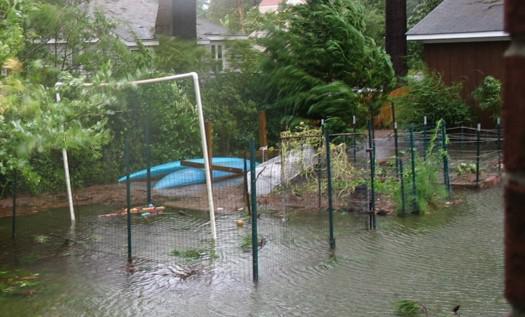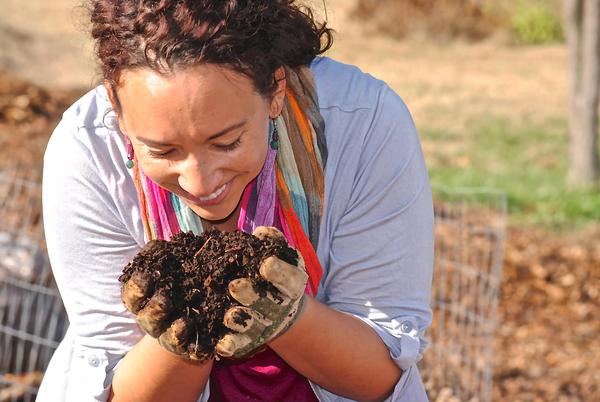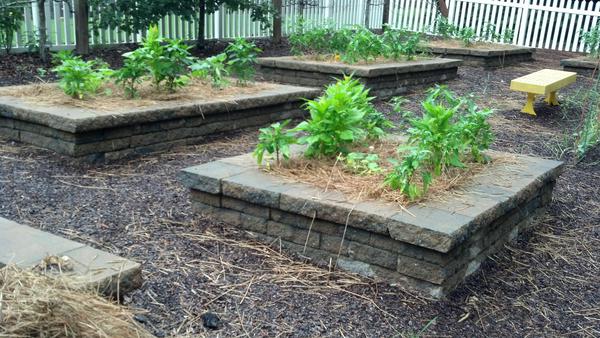Introduction
Floodwaters can carry chemical and biological contaminants that harm human health. Flooded vegetable gardens (Figure 1) can harbor risks to people who touch contaminated plants and soil, consume harvested produce, or breathe in dust from soil.
Chemical contaminants carried by floodwaters may include salt, lead, heavy metals, and pesticides. Biological contaminants may include bacteria, viruses, and parasites from raw sewage, raw manure, dead animals, and sediment and organic matter eroding from or running off nearby areas. Specific biological contaminants may include biological Vibrio species, Salmonella species, pathogenic E. coli, hepatitis A, norovirus, Listeria monocytogenes, and Cryptosporidium.
Gardeners can take specific actions before a flood, after the storm, and after floodwaters recede to reduce health risks from floodwaters.
Before a Flood
Select a site that is unlikely to flood (away from a floodplain or the bottom of a slope) (Figure 2) or move your existing garden to a less flood-prone location. Notice where rainwater flows during heavy downpours and avoid planting in areas where water collects, if possible. If necessary, install raised beds or use flood-resistant or permaculture design techniques like swales and rain gardens.
Investigate surrounding land use to identify sources of contamination that may compromise your garden site. Avoid locating gardens within 1,000 feet of the following potential sources of contamination:
- Former or active agricultural land or land to which municipal sludge has been applied (due to the risk of contamination from pesticides, heavy metals, or PFAS)
- Sites with heavy pesticide use or heavy historical pesticide use
- Landfills created before 1983 (can leach contaminants into groundwater and nearby land)
- Brownfields (active or former industrial or commercial sites that may be contaminated with a variety of chemicals)
- Coal ash ponds (unlined coal ash ponds can spill over onto surrounding land or into waterways used for irrigation)
- Sites that contain a lot of machinery, including vehicles and heavy equipment that could leak oil or gasoline
- Storage sites that contain a large volume of household chemicals, oils, and fertilizers
- Dry cleaning operations (can present a groundwater contamination risk due to underground spread of chemicals like trichloroethylene, or TCE)
- EPA Toxic Release Inventory sites
- Hazardous waste treatment, storage, and disposal facilities
- Superfund sites
- Underground Storage Tanks (may become flooded and spill over)
- Houses or painted structures built before 1978 that are likely to contain lead paint
- Major roadways
The Duke University Superfund Research Center addresses environmental health concerns resulting from a hurricane. The site includes a GIS map tool showing potential sources of contamination in North Carolina. This can help you identify which chemical contaminants may be present and focus the scope of soil testing. Another useful map resource is the North Carolina Department of Water Quality’s Division of Waste Management Site Locator Tool.
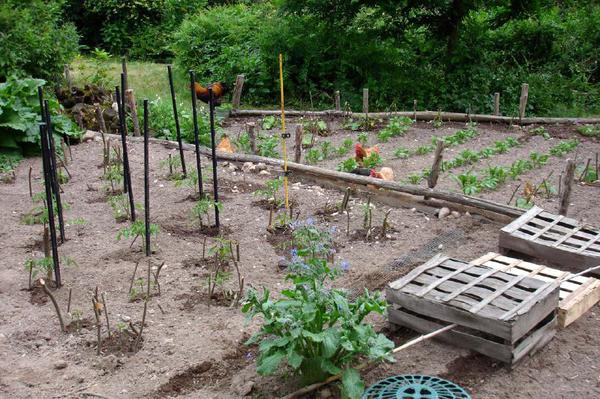
Figure 2. Planting on a hilltop is a good way to improve drainage and prevent flooding.
Photo by hardworkinghippy (Flickr) CC BY-SA 4.0
After the Storm
Document
When safe, take photographs to document how high the water rose and which plants were affected (Figure 3). Make particular note of edible plants that were touched by floodwater. Record how long the site is flooded. Note the clarity and color of the water as well as any unusual substances in the water, but do not handle unrecognizable substances that may be a source of contamination. This information will be helpful in identifying potential contaminants. Share this information with experts to identify the substances, especially if you experience crop failure or related issues in the future.
Follow Food Safety Guidelines for Flooded Crops
Pathogens may be present even in stormwater that looks clean. For example, pathogenic E. coli, hepatitis A virus, Listeria monocytogenes, norovirus, Salmonella species, and Vibrio species are common in floodwaters but not visible to the naked eye. Once floodwaters introduce pathogens to the garden, you can do very little to remove them from growing or harvested plants. Especially vulnerable are tomatoes, leafy greens, and other produce with tiny crevices to which pathogens can attach.
The Centers for Disease Control and Prevention estimates that fresh, raw produce is linked to about half of all foodborne illness. Discard all harvested produce that will not be cooked and any of the edible parts that touched floodwater. Remember that cooking destroys only biological contaminants, not chemical ones. Discard produce when fruits have set (tomatoes, peppers, eggplant) or where you see edible buds (broccoli or cauliflower) at the time of flooding.
Underground crops in soil that has been covered by floodwater are considered unfit to sell or eat, even though they may look normal. The edible portions of the underground crops may have touched the floodwater that seeped into the soil. In addition, the U.S. Food and Drug Administration (FDA) does not believe it is possible to harvest underground crops from flooded locations without risking contamination from flood-affected soil.
Consuming late-season vegetables originating from buds, leaves, and flowers produced after the flood would be low risk. According to FDA, the likelihood of contamination may be low if the edible portion of the crop developed after the floodwater receded or the lowest edible portion of the crop was above the floodwater level with minimum risk of contamination due to splashing and the crop can be harvested without cross-contamination from nearby flooded soil or the flooded portion of the crop. To avoid eating soil particles, carefully wash produce and peel it to remove any soil residue.
For advice about the safety of edible parts of the crop that did not contact floodwaters, consult your local N.C. Cooperative Extension center.
After a storm, mosquitos can become a problem. Spraying shrubs is unlikely to have a significant benefit. Do not spray edible crops unless the pesticide is specifically labeled for use on that plant. Visit NC State Extension’s Mosquito Control Around Homes and in Communities page to learn about additional management strategies, including using Bt products in small bodies of standing water and insect repellent.
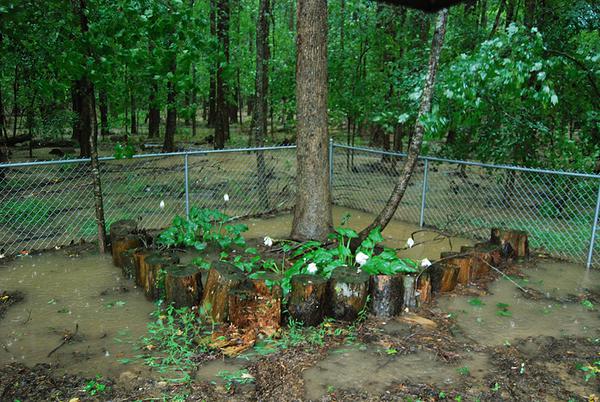
Figure 3. Document water levels, affected plants, unidentified substances, and other flood effects through photos and notes. Your observations may help experts provide advice about mitigation.
Photo by Jeffrey L Cohen CC BY-NC-ND 2.0
After the Floodwaters Recede
Keep anyone who may be especially vulnerable to contaminants away from the floodwaters and the garden until contamination is addressed. This includes young children, elderly people, pregnant women, nursing mothers, or anyone who is immunocompromised. You can be exposed to contaminants through breathing, touching, eating, or drinking. Avoid touching or drinking floodwaters, and do not use this water to irrigate your garden. Sources of irrigation such as private wells, city water, and ponds may have been contaminated. Check local and state advisories for recommendations about using wells or ponds to irrigate food crops. See the FDA guidance for flood-affected food crops.
Consider Testing Soil and Water
If you are concerned about chemical contaminants and want to replant your garden, you may want to have your soil tested. Though it is possible to test for the presence of chemicals, there is no effective test to identify biological contaminants in the soil. Identify what types of contaminants may be present to determine the appropriate type of test. Contact a local lab to test for specific chemical contaminants in the soil. (The North Carolina Department of Agriculture & Consumer Services [NCDA&CS] Agronomic Services Division Laboratory and most commercial agricultural laboratories do not typically provide tests for chemical contaminants.) Small farms can receive assistance with crop assessments from the NCDA&CS and N.C. Cooperative Extension. To learn more about soil testing to identify contaminants, see the SoilFacts publication Minimizing Risks of Soil Contaminants in Urban Gardens. To learn more about testing for soil salinity after flooding with saltwater, see the SoilFacts publication Effects of Wind-Induced Sodium Salts on Soils in Coastal Agricultural Fields.
You may also want to evaluate your irrigation water source to see if it was contaminated by chemical or biological pollutants during flooding.
Safely Clean up the Garden
- Wear personal protective equipment (for example, gloves, masks, and closed-toe shoes) while working.
- Remove debris and throw it in the trash. Do not compost residue from a flood.
- Wash your hands frequently during and after garden cleanup.
- Clean your tools frequently.
- Mulch paths and walkways between planting beds to suppress dust that may contain contaminants.
- Remove clothes and shoes before entering your home to prevent tracking in any contaminants.
Prepare to Replant
- Submit a soil sample for testing to determine lime and nutrient needs; follow the soil test recommendations.
- Allow the ground to dry out enough to be worked. Thoroughly till the soil as deeply as possible, preferably at least 6 inches. Incorporate organic matter (Figure 4) to further dilute contaminants and bind heavy metals, reducing the chance that plants will absorb harmful substances.
- Consider making your first planting a cover crop or an ornamental crop. This will help renew the health of the soil.
- Wait at least 100 days after the floodwaters recede to plant edible root crops, at least 60 days to replant other edible crops, and at least 120 days before harvesting any edible produce.
- Maintain a soil pH at or close to neutral (6.5 to 7.0) because lead and some other heavy metals are less available to plants within this range.
If your soil has been contaminated, consider growing food in imported healthy soil in containers or raised beds (Figure 5). Place a plastic liner or other barrier beneath the raised bed to prevent vegetable roots from penetrating any contaminated native soil. Include drainage holes at the bottom of the sides of the bed rather than beneath the bed. For more information, see Raised-Bed Planters in the Collard Greens and Common Ground: A North Carolina Community Food Gardening Handbook.
Summary of Best Practices
- Choose a garden site that is not in a floodplain or near any known sources of contamination.
- Consider growing nonedible plants if your garden is in a floodplain.
- Discard produce that comes in contact with floodwaters; do not compost.
- After floodwater recedes, wait at least 60 days to replant (100 days for root crops) and 120 days to harvest any edible produce.
- Test garden soil for any suspected chemical contaminants deposited by floodwaters.
- Maintain a neutral soil pH and add organic matter each season before planting so that lead and heavy metal contaminants are less available to plants.
Acknowledgment
This work was supported through the National Institute of Environmental Health Sciences P42 Multi-project Center Grant program, grant number P42ES010356.
Publication date: Sept. 24, 2020
AG-882
N.C. Cooperative Extension prohibits discrimination and harassment regardless of age, color, disability, family and marital status, gender identity, national origin, political beliefs, race, religion, sex (including pregnancy), sexual orientation and veteran status.

